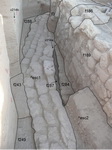1. OVERVIEW
| Roster | Date | Author | Record |
|---|---|---|---|
| Includes other label | 2009-08-11 | sE | f188 (escarpment), f225 (escarpment), f265 (escarpment), f293 (escarpment) [Input: T811SE1.j] |
| Best definition | 2009-08-11 | !! | escr [Input: T811SE1.j] |
| Best image | 2009-09-15 | jW |  v214 [Input: T915JW.j] |
2. IDENTIFICATION
Designation
| Roster | Date | Author | Record |
|---|---|---|---|
| Definition | 2009-08-11 | sE | escr [Input: T811SE1.j] |
| Description (summary) | 2009-08-11 | sE | The first escarpment is composed by a series of rows of big, flat stones (at least four rows), running E-W south to the wall escarpment f189. The material used for this structure, stone, was due probably to the presence of water running along the wall: its aim was to preserve the foundation of f189 and to prevent its collapse. [Input: T811SE1.j] |
3. STRATIGRAPHY
Recovery/Assignment
| Roster | Date | Author | Record |
|---|---|---|---|
| Harmonization | 2009-09-29 | jW | The revetment wall, f189, in J5 is 2.4m high, while in J1 it is 3.4m high. The tops are at about the same elevation, implying that the base of the J5 segment must be 1m higher, stepping up between the units. An E-W line of stones atop the baqaya first escarpment in J1 is aligned with, is the same elevation as, and joins the top row of ^esc1 stones in J5. Where is the baqaya in J5? The best answer is that it stops at the point where it abuts the step, while the stones continue on. [Input: T929JW.j] |
| Evolution | 2009-08-12 | jW | fAB raised the issue of which wall system ^esc1 follows as it approaches the western extent of the revetment wall, f189. Does it follow f189 and end with it, or does it continue further to the west and protect wall, f41 also, receeding under the Mittani revetment wall, f3. [Input: T812JW.j] |